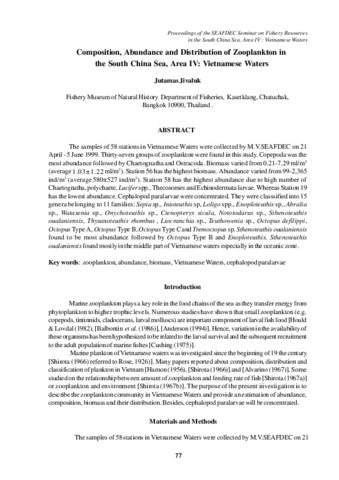Composition, abundance and distribution of zooplankton in the South China Sea, Area IV: Vietnamese waters
Share
Abstract
The samples of 58 stations in Vietnamese Waters were collected by M.V. SEAFDEC on 21 April - 5 June 1999. Thirty-seven groups of zooplankton were found in this study. Copepoda was the most abundance followed by Chaetognatha and Ostracoda. Biomass varied from 0.21-7.29 ml/m3 (average 1.03±1.22 ml/m3). Station 56 has the highest biomass. Abundance varied from 99-2,365 ind/m3 (average 580±527 ind/m3). Station 58 has the highest abundance due to high number of Chaetognatha, polychaete, Lucifer spp., Thecosomes and Echinodermata larvae. Whereas Station 19 has the lowest abundance. Cephalopod paralarvae were concentrated. They were classsified into 15 genera belonging to 11 families: Sepia sp., Inioteuthis sp, Loligo spp., Enoploteuthis sp., Abralia sp., Watasenia sp., Onychoteuthis sp., Ctenopteryx sicula, Nototodarus sp., Sthenoteuthis oualaniensis, Thysanoteuthis rhombus , Liocranchia sp., Teuthowenia sp., Octopus defilippi, Octopus Type A, Octopus Type B, Octopus Type C and Tremoctopus sp. Sthenoteuthis oualaniensis found to be most abundance followed by Octopus Type B and Enoploteuthis. Sthenoteuthis oualaniensis found mostly in the middle part of Vietnamese waters especially in the oceanic zone.
Suggested Citation
Jivaluk, J. (2001). Composition, abundance and distribution of zooplankton in the South China Sea, Area IV: Vietnamese waters. In Proceedings of the Fourth Technical Seminar on Marine Fishery Resources Survey in the South China Sea, Area IV: Vietnamese Waters, 18-20 September 2000 (pp. 77-93). Bangkok, Thailand: Secretariat, Southeast Asian Fisheries Development Center.


